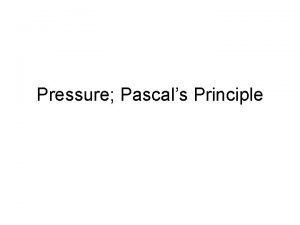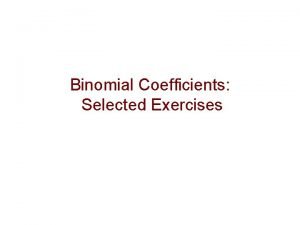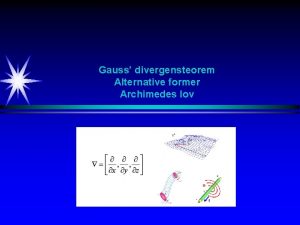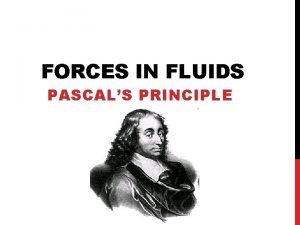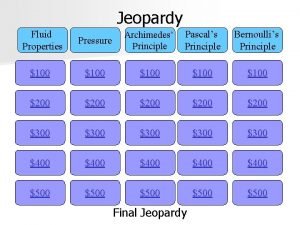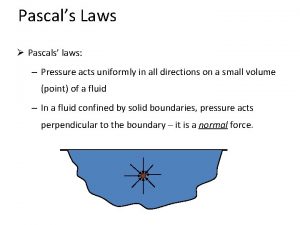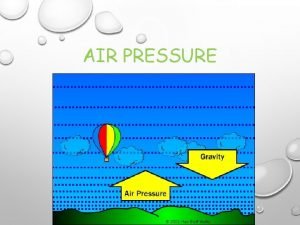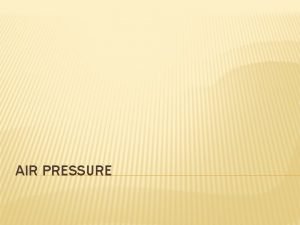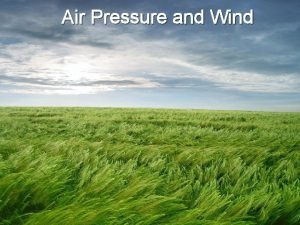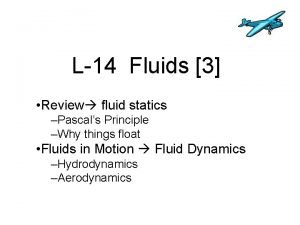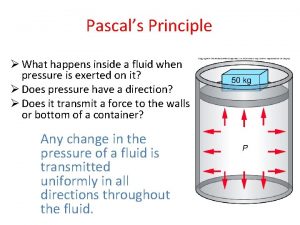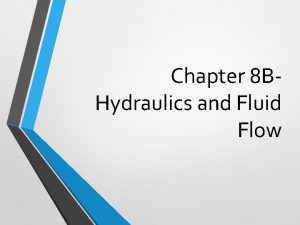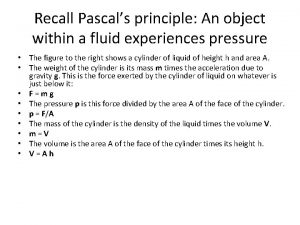Pressure Pascals Principle PRESSURE OF A FLUID air



















- Slides: 19

Pressure; Pascal’s Principle

PRESSURE OF A FLUID air pressure = height of mercury column Barometer

Gauge pressure – pressure above the atmospheric pressure. absolute (total) pressure = gauge pressure + atmospheric press.


Pressure is produced by the weight of the fluid above the surface.

force weight of fluid pressure = -----------area mg density · volume · g = ---------------area density · (area · height) · g = ----------------area

pressure = density · height · g P = ρhg gauge pressure P = ρhg + P 0 absolute pressure SI units: 2 pressure: N/m = Pascals (Pa) 3 density: kg/m height (depth): m

Standard atmospheric pressure 760 mm Hg ≈ 30 in Hg Calculate 1 atm in Pascals P = ρgh 3 10 3 kg/m ρHg = 13. 6 x g = 9. 8 N/kg h = 0. 760 m 5 P = 1. 013 x 10 Pa

Why does a barometer use mercury and not water? If p = 1 atmosphere = 1. 013 x 3 g/cm ρ = 1. 00 Find height. = 1. 00 x 10. 3 m 3 10 5 10 Pa 3 kg/m

Pressure of fluid depends on depth.

Pressure does not depend on volume, only on height (depth). “Water seeks its own level”

More pressure at greater depth

Measure blood pressure at upper arm same height as heart

Pascal’s Principle – The pressure in an enclosed fluid is constant throughout the fluid. p 1 F 1 --A 1 = = p 2 F 2 --A 2

1 N ? A = 1 cm 2 p 1 = 1 N ------- = 2 1 cm A = 50 cm 2 p 2 F 2 -----2 50 cm 50 N

If piston on left moves 10 cm, what distance does piston on right move? work 1 = work 2 F 1 d 1 = F 2 d 2 (1) (10) = (50) d 2 0. 2 cm

Hydraulic lift

Area of brake cylinder > area of brake line force of brake cylinder > force of brake pedal

hydrostatic pressure
 Pascal's law
Pascal's law ρhg
ρhg Binomial coefficient exercises
Binomial coefficient exercises Binomial theorem pascal triangle
Binomial theorem pascal triangle Flaccid cell
Flaccid cell Yang huis triangle
Yang huis triangle Pascal's triangle hockey stick pattern
Pascal's triangle hockey stick pattern Arkimedes lov
Arkimedes lov How is pascal's principle used in everyday life
How is pascal's principle used in everyday life Pascals triangle 8
Pascals triangle 8 Pt tanah air sentosa
Pt tanah air sentosa Hail
Hail A swirling center of low air pressure is called
A swirling center of low air pressure is called Synovial membrane
Synovial membrane P1-p2
P1-p2 Fluid statics deals with
Fluid statics deals with Intracellular fluid and extracellular fluid examples
Intracellular fluid and extracellular fluid examples Interstitial fluid vs extracellular fluid
Interstitial fluid vs extracellular fluid Interstitial vs intracellular
Interstitial vs intracellular What is fluid kinematics
What is fluid kinematics

